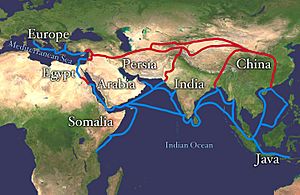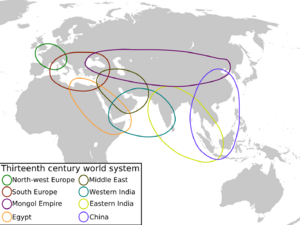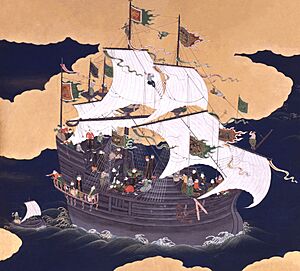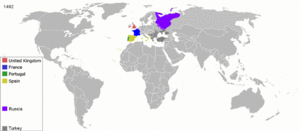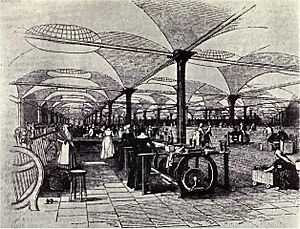History of globalization facts for kids
Globalization is all about how people, countries, and businesses around the world become more connected. This includes sharing ideas, goods, and cultures. Think of it like the world becoming one big neighborhood!
People have different ideas about when globalization really started. Some say it's a new thing, from around the 1800s. Others believe it began thousands of years ago, which they call archaic globalization. There's also a time called proto-globalization, which was roughly between 1600 and 1800.
Contents
How Experts Divide Globalization's History
Some experts have divided the history of globalization into different periods. This helps us understand how it changed over time.
Three Eras of Globalization
A writer named Thomas L. Friedman sees three main periods:
- Globalization 1.0 (1492–1800): This was about countries becoming more connected.
- Globalization 2.0 (1800–2000): This period focused on companies connecting globally.
- Globalization 3.0 (2000–today): Now, individuals are connecting more easily across the world.
Four Eras of Global Connection
Other experts, like Klaus Schwab from the World Economic Forum, see four eras:
- Globalization 1.0: Before World War I.
- Globalization 2.0: After World War II, when countries traded goods and worked together.
- Globalization 3.0: A more recent time where global businesses changed a lot, with companies moving parts of their work to other countries.
- Globalization 4.0: The current period (from 2018), where services are especially affected by global changes.
Early Global Connections: Archaic Globalization
The very first signs of globalization can be found way back in history. Some say it started when ancient civilizations like Sumer and the Indus Valley civilization traded goods thousands of years ago.
Even in prehistoric times, our ancestors spread across all five continents. This was a key step in connecting the world. When people started farming, they settled down. This also helped connect different groups. However, without good ways to travel or share information, globalization didn't speed up much back then.
During the Hellenistic Age, an early form of global economy and culture appeared. Greek culture spread from India to Spain. Cities like Alexandria and Athens became important trading centers. This was also when the idea of a "world city" (Cosmopolis) first came up.
Trade also linked the Roman Empire, the Parthian Empire, and the Han Dynasty in China. These connections led to the famous Silk Road. This route started in western China and stretched all the way to Rome.
The Islamic Golden Age and Global Trade
The Islamic Golden Age was another important time for early globalization. Jewish and Muslim traders and explorers created a strong trading network across the Old World. This led to a "globalization of crops," trade, knowledge, and technology. Important crops like sugar and cotton were grown widely. Learning Arabic and making the Hajj (pilgrimage to Mecca) also helped create a shared culture.
The rise of the Mongol Empire helped travel along the Silk Road. This allowed travelers like Marco Polo to journey across Eurasia. The Pax Mongolica (Mongol Peace) in the 1200s also had global effects. It created the first international postal service. It also sadly helped spread diseases like the bubonic plague across Asia.
Before the 1500s, even the biggest global trade systems were mostly limited to the Old World (Europe, Asia, Africa).
Proto-Globalization: New Sea Routes
The period known as proto-globalization began with European empires sailing the seas. This started in the 1400s, 1500s, and 1600s with Portugal and Spain. Later, the Dutch and British empires joined in.
In the 1600s, globalization also became a private business. Companies like the British East India Company (1600) and the Dutch East India Company (1602) were formed. These were some of the first big international companies.
The Age of Discovery and Global Exchange
The Age of Discovery brought huge changes. For the first time, Europe, Asia, and Africa connected with the New World (the Americas). This began in the late 1400s. Portugal and Spain sent ships to explore. Christopher Columbus "discovered" the Americas in 1492.
Soon after, the Portuguese set up trading posts from Africa to Asia and Brazil. They traded local goods like slaves, gold, spices, and timber. This created a global business network run by the king.
Global connections grew with the European colonization of the Americas. This led to the Columbian Exchange. It was a huge exchange of plants, animals, foods, people (including slave labor), diseases, and cultures between the Eastern and Western parts of the world. This was one of the most important events in history for how our world's ecology, agriculture, and culture developed. New crops from the Americas, brought by European sailors, greatly helped the world's population grow.
Modern Globalization: The World Connects Faster
The 1800s saw globalization become much more like it is today. Factories could make many items cheaply. Also, more people meant more demand for goods.
This period was strongly shaped by imperialism. After wars that opened up China to foreign trade, and Britain's control of India, many people in these areas started buying European goods. Parts of Africa and the Pacific islands also became part of this global system. Europeans took valuable resources like rubber, diamonds, and coal from these areas. This helped trade and investment grow between European empires, their colonies, and the United States.
One famous quote describes this time: "The person in London could order by telephone, sipping their morning tea, the various products of the whole earth, and expect them to arrive soon. War and rivalries were just news in their daily paper. What an amazing time in human economic progress that ended in August 1914."
There are big differences between globalization in the 1800s and the 1900s.
Global Trade Changes
- More Trade in Goods: In the 1900s, a bigger share of goods made were traded globally.
- Growth of Services: Trading services (like banking or tourism) became much more important.
- Rise of Multinational Companies: Companies that operate in many countries grew a lot in the 1900s. Before then, most international investments were just buying shares, not setting up factories or businesses in other countries.
Trade has improved a lot since the 1800s. It's easier to trade now because there are fewer barriers. Transport costs have also gone down. Countries have signed many trade agreements, like the General Agreement on Tariffs and Trade (GATT) and the North American Free Trade Agreement (NAFTA). The European Union (EU) has also removed taxes on goods traded between its member countries. The World Trade Organization (WTO) helps manage global trade.
It used to take weeks or months to ship goods between continents. Today, it only takes a few hours!
Globalization Slows Down: After World War I
The first phase of "modern globalization" started to break down with World War I. European countries, who had a lot of power, began to face challenges. They were also looking for resources in other parts of the world, sometimes using unfair practices.
The increase in world trade before 1914 encouraged countries to take direct control of colonies in the global South. For example, France had colonial rule over much of Africa. At first, France was interested in Africa's military potential. Later, during a food crisis in 1917, France also looked to Africa for economic help.
Globalization Returns: After World War II
After World War II, globalization started to grow again. Politicians worked to remove barriers to trade. This led to the Bretton Woods conference. Here, world leaders set up rules for international trade and money. They also created new international groups to help manage globalization.
Globalization was also pushed by big companies from the United States and Europe expanding worldwide. New ideas in science, technology, and products were shared globally. Most major inventions from this time came from Western countries. The spread of western culture happened through new mass media like film, radio, television, and music. Better international transport and telecommunication also played a big part.
New Global Organizations
Important groups created after World War II include:
- The World Bank (International Bank for Reconstruction and Development)
- The International Monetary Fund
These groups, along with new technology, made trade cheaper. Trade talks, especially under the General Agreement on Tariffs and Trade (GATT), led to agreements to remove trade limits.
Since World War II, it has become much easier to trade internationally. This is thanks to agreements like GATT and the World Trade Organization (WTO). Some key changes include:
- Free Trade: Removing taxes on imported goods and creating free trade zones.
- Lower Transport Costs: Especially with the invention of containerization for shipping goods by sea.
- Easier Money Movement: Reducing limits on how money can move between countries.
- Fairer Rules: Trying to make rules for businesses and intellectual property (like patents) similar across many countries.
At first, cultural globalization was seen as making everything the same, with American culture taking over. But then, people started to protest this. They wanted to protect their local cultures and unique identities.
The Uruguay Round (1986-1994) led to the creation of the WTO. This group helps solve trade disagreements and sets up common trading rules. Other agreements, like parts of Europe's Maastricht Treaty and NAFTA, also aimed to reduce trade barriers.
Global exports grew from 8.5% of the world's total goods in 1970 to 16.2% in 2001.
In the 1990s, cheap communication networks allowed jobs that use computers to be moved to countries where wages were lower. This included accounting, software development, and engineering. In the late 2000s, many rich countries faced a big economic downturn. Some experts thought the world was becoming "less globalized" after years of growing connections. However, China has since become the world's largest exporter.
See also
- History of capitalism
- Human history
- Military globalization


